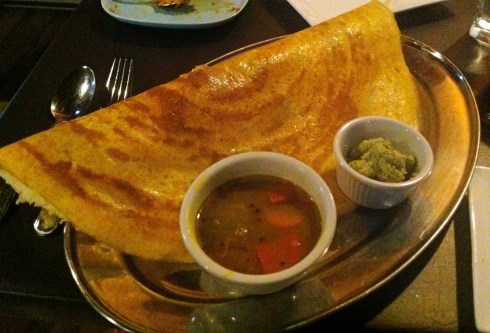Sushi, marinated chicken feet, pho, extra-tall burgers, ramen, raw oysters, injera, prawns, crab, Indian buffets, extra-rare steak, spiral-cut ham. Over the years, all those things, and more, have caused consternation as I fumbled over how to eat them properly. A bit about this below and in later posts.
But first, the dosa experience.
This past weekend, a friend introduced me to dosa. Because I’ve led a not-that-well-travelled life, I had never encountered dosa. Eating my first one was an entertainingly delicious experience. It was, as with the most memorable food moments, more than just the eating. There was anticipation, the visual wow when it arrived with all the components, and the watching as my colleague instructed me on his method for tackling a dosa.
A dosa is a crepe made from a rice and lentils batter, with origins in India. In my case, it was a giant crepe that filled a plate even when it was folded in half. Making one looks like it takes a lot of skill and experience. (I’ll ask if I can watch next time.)

I had a masala dosa, with spicy potato and onions in the middle. It came with small containers of coconut chutney and sambar, vegetables in a tasty broth. I didn’t know how to begin eating it.
“This is the way I do it,” said my friend, who grew up in India. He spread the chutney on the dosa with a knife, tore apart the dosa, and drizzled on some sambar with a spoon. I followed his example. It was a dish with many characteristics — crunchy, soft, stretchy, spicy. I would have it again. And will.
We are often judged by the way we eat our food. And that judging is different in different cultures. Growing up in a Chinese household, slurping was no big deal. Our family has peasant roots. I quickly discovered that slurping was not well regarded outside our home. I don’t remember the moment when that sank in, but it did at some point. Since I can’t remember it, it mustn’t have been too traumatic.
Someone, or maybe a bunch of someones, decided that it isn’t proper to dip your sushi rice ball into soy sauce. If you dip at all, dip the fish, not the rice.
When eating raw oysters on the shell, don’t pour out the oyster liquid. Slip it into your mouth with the oyster. Chew the oyster, don’t just swallow it.
At a Chinese table, with communal dishes, it’s OK to reach, at least in my circle. Using communal chopsticks to bring the food to your plate or bowl is a touch higher class. Not well regarded: reaching to the opposite side of a dish to pluck a particularly choice morsel.
The BBC produced a show called Jane Austen’s Pride and Prejudice: Party like it’s 1813. The commentators said it was perfectly acceptable to reach and help yourself at the dinner table.
There can be so much to occupy your mind when you eat, quite apart from the act of eating. Eating my first dosa, for example, led to all this reflecting about eating.
- - -
How to make masala dosa, from vegrecipesofindia.com
Dosas are on the menu here in Victoria.
- - -
- - -
Most-read posts:
If your garbage bin is overfilled, it might not be emptied
Tips to make applying for a passport a little easier
Flying business class is not the same as first class
Energy efficient light bulbs are finally worth buying
How to pronounce Ucluelet, Tsawwassen, and that outdoor gear place
How I like to make popcorn (cautiously) on a stovetop
Vancouver to Toronto by train: enjoying the journey
- - -


